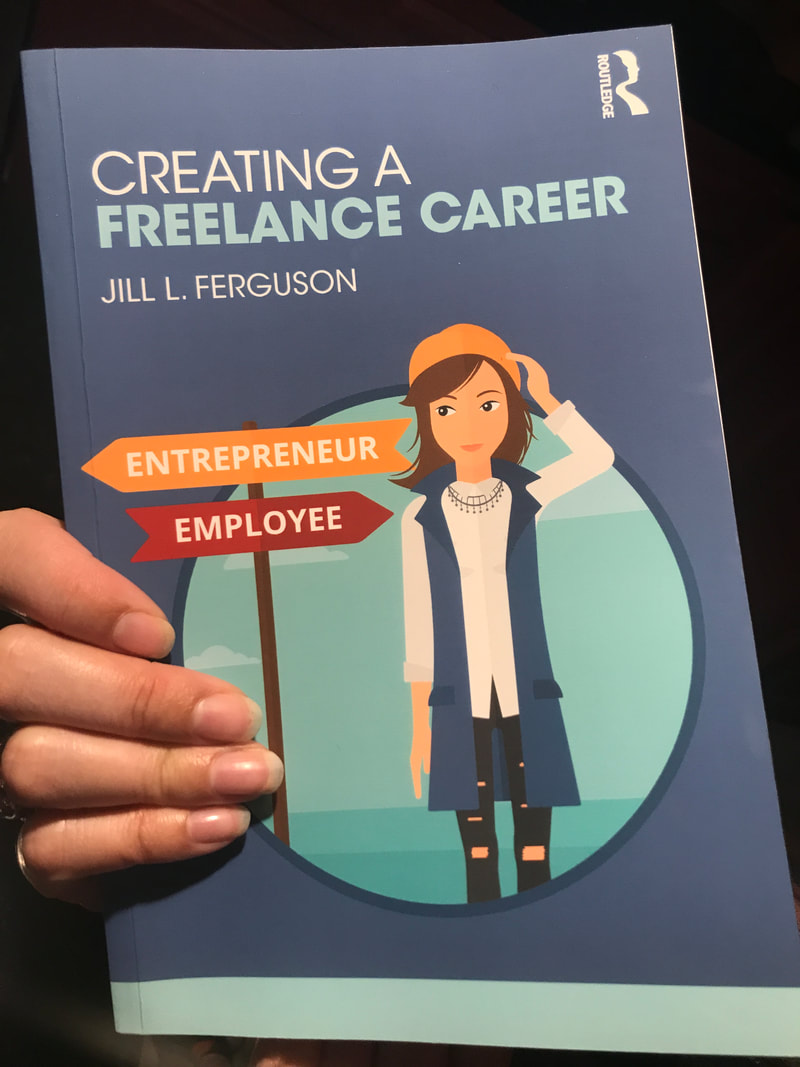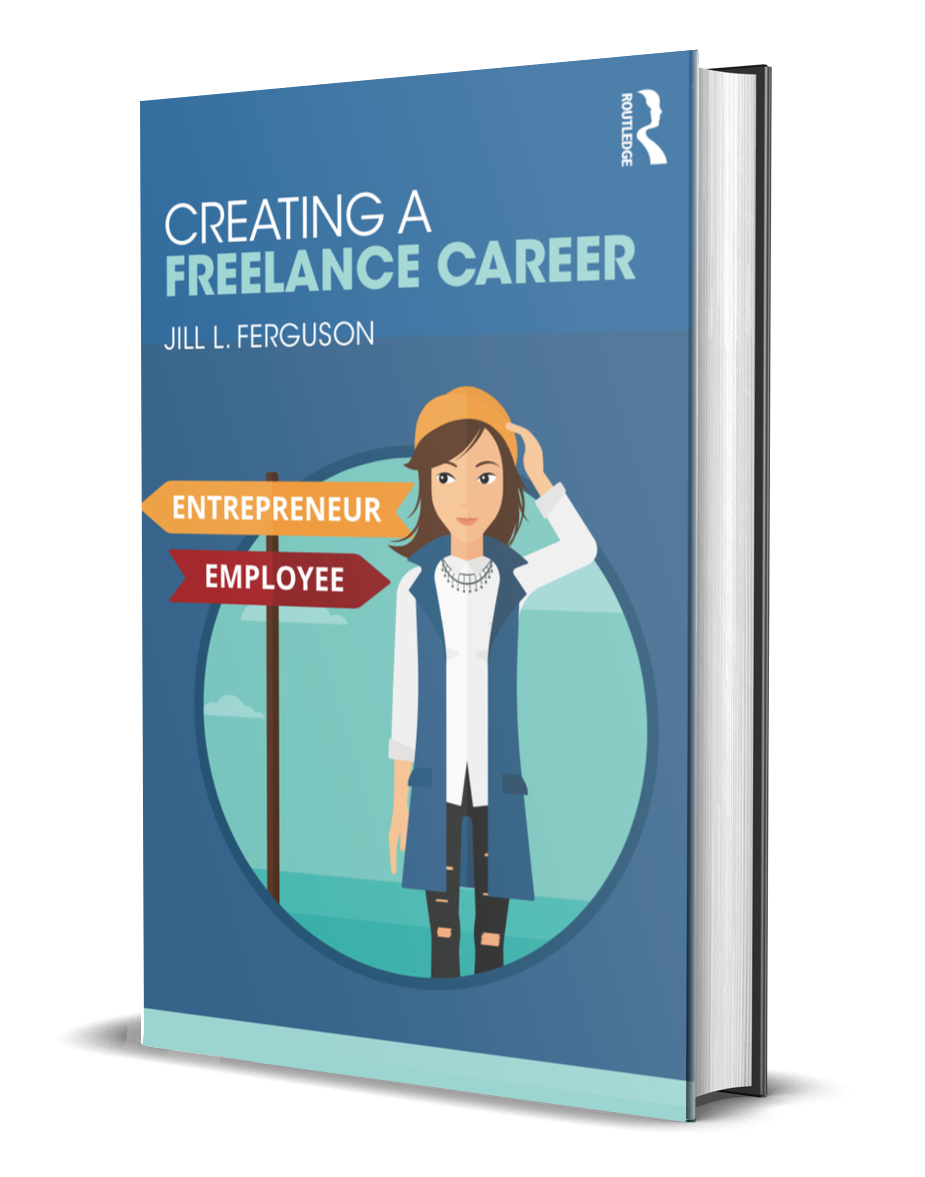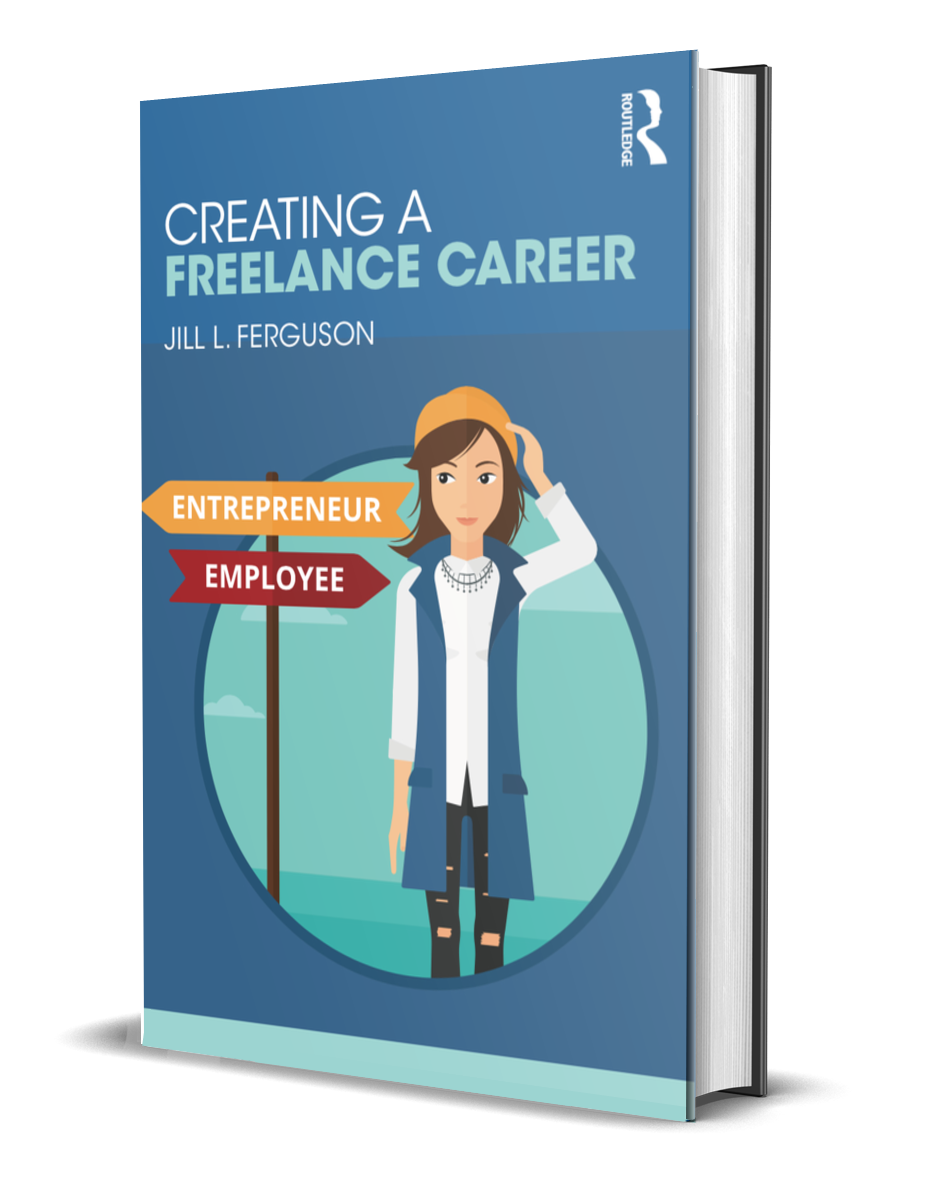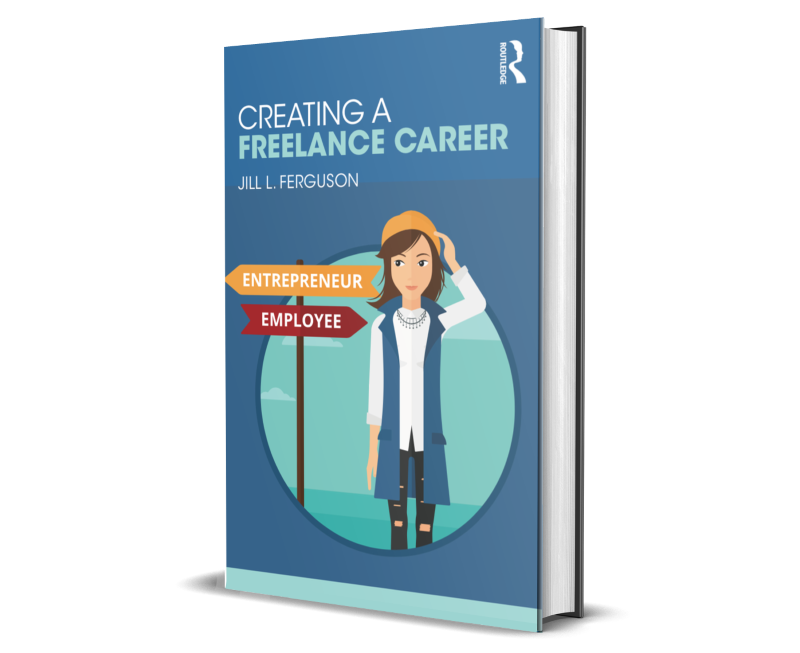|
Creating a Freelance Career has been ranked the number one business book on the Fupping.com list of "The 22 Books Every Business Student Should Read." We are excited for this honor, and I thank everyone who voted us from the number 4 spot when the list was published to the number 1 spot.
Also, I've been doing live radio interviews this week promoting the book. On Monday, I talked with Larry and Robin on AM Ocala and today I was on "Open Line" on KIKO-AM in Claypool, Arizona. On November 20, the taped segment I did for .School for Start-Ups will air. (I'll post the link when it is ready.) And my publicist has me booked on many more shows in the coming weeks. Stay tuned for more information. And again, thank you for making Creating a Freelance Career the number one book for business students. #gratitude #entrepreneurship #freelance
0 Comments
 Over the weekend after I hosted a women's retreat in Seattle one of the participants, and a dear friend, talked to me about a business conference she attended a few weeks ago. One of the speakers is a business coach who gets paid in the six figures to work with each of his clients. He boasted that he will only take on clients who have bodacious dreams and how only he can get them to where they want to go. I found this information--both how it was said and the implications behind it--troubling. Like Jen Sincero , of Bad Ass fame, I don't believe in framing things from a place of lack. When consultants and coaches market themselves as "you need me to get you to where you want to go" that implies that you yourself are lacking. And we don't get to where we need to go by focusing on our "lack". We get to where we need to go and where we want to go in life and in business by tapping into our inner strength, our skills, our talents and our inner wisdom. We all have those in abundance, but sometimes we need a cheerleader to encourage us. Or we need someone to show us the way or to hold our hand and support us. .Or maybe even a person to challenge us in our thought processes and our self-imposed limitations. These are the roles of an excellent and empathetic coach or consultant. So next time you are thinking of hiring a coach or consultant, think about what you want. Do you want someone who tells you aren't good enough and do not have what it takes without them? Or do you want someone who helps you tap into and grow into your best self? Erica Ledesma has won a copy of Creating a Freelance Career in the six-week book giveaway. Thank you to all who entered this competition, and check back for future giveaways and news.
 A guest post by Debbie Page Here in the PNW summer is the time that most of us don't want to leave the region. The skies are blue, the weather perfectly warm, the days light and long. It's a time I love to adventure locally; trips to the Long Beach Peninsula, biking adventures with friends, road trips to Oregon for weddings and long visits with family. Maybe you, like me have arrived at a place in life where you like things a certain way. When it comes to my vacations there are a few things I don't like to be without, maybe you can relate.
In recent surveys, Americans admit to spending more time planning vacations than retirement and spend an average of 15 hours planning a family vacation. This number can double if it's an unfamiliar destination, and Expedia says, we visit 38 travel sites before we book a trip. If we do some simple math (one of my favorite things) if you take two trips each year that's minimally 30 hours you're investing to planning two weeks of family fun and adventure. Now stop and ask yourself, how much time do you allocate to planning your business each year? Really, stop to think about it. Have you ever thought, "Wow, I have SO much time and not enough to do in it?" I am guessing no. Part of why entrepreneurs don't allocate time well is because there is no ritual when it comes to planning and evaluating business activities and results. It gets crammed in between dozens of competing priorities. You are running an entity that allows you the opportunity to create the wealth you desire for yourself and your family. How much time is on your calendar to plan the actions of your business? An hour each week? An hour each month? Do you dedicate focused time each year to plan for the next? Do you block out time quarterly to review your progress and make adjustments as needed? Now you might be thinking, "C'mon Debb, you've said this in some fashion before." You are correct. And I'll keep reminding you of the correlation between time spent planning, evaluating results and course correcting and the revenue and profit in your business. Go mark the first 15 minutes every morning this coming week for planning your day, then mark the last 15 minutes of your work day to wrap up and evaluate what you accomplished and what is the priority the next day. Do this for a week and evaluate your results. I know you will have accomplished more and be more confident about your progress and direction and the money that is working it's way toward you. If you are ready to put a system in place that can support your success, then maybe it's time to considering working with me. If coaching is part of what you want to implement in the last half of 2018 then I invite you to schedule a complimentary conversation with me to discuss what's happening in your business and learn what it would look like to work together. You can schedule directly on my calendar here. Warmly, Debbie Page  Sometimes size really does matter. In the world of digital marketing, Yuri Elkaim and others state that the marketing funnel that creates sales looks like: Content which leads to a lead magnet that captures e-mail addresses to a no-brainer offer (which converts the browser to a customer) to a core or back-end offer (higher priced that provides added service and value). Underlying this whole process is the idea that each step provides the potential customer or customer something of value and that the level of value increases which helps build trust in the relationship. In the case of Healthpreneur and others, for example, this may look like free articles and maybe a booklet (for which the customer pays shipping and handling only), followed by an offer for a free phone call or for a video recording of a one-day long conference, followed by an invitation to a longer in person conference or person coaching program.
Or for another example: How many times have you been exposed to an author unknown previously to you on Amazon with a promotional deal on that author's book. Maybe you were offered a one-day only, acquire it for free price, or for 99 cents or $2.99. The author or publisher does this because they hope the discounted price causes you to purchase, and then, after you enjoy your experience with that first discounted story, you'll want to read more from that author and be willing to purchase things at full price. Marjory Kaptanoglu did this successfully with her novel Dreadmarrow Thief, as she explains in my new book, Creating A Freelance Career. This marketing concept is also the reason why every person or company with a mailing list or a site subscription offers you free educational, informative, and/or entertaining information on a regular basis. The idea is to create content that people find valuable and will want to follow you. This content can be done through writing articles, releasing snippets of songs if you're a composer or a sneak preview of a music video, or creating video content. Musician and painter Andrew Cadima entertains his audience with YouTube video that captures his painting process, as you can see if you click on his name in this sentence. The videos show the beauty in his work and his skill and they entice the viewer to want to see more, by maybe even joining or following his YouTube channel so they never miss the next installment. While potential customers/clients and current clients need regular useful content from the people or companies they follow, the question remains how much content should you provide and how long should that content be? I, for one, have immediately unsubscribed when I've felt like the content provider was in contact way too often, such as daily or multiple times per day. My exception to this rule is content providers who send out a daily quote in the morning. No one wants to feel badgered or pressured. And since we live in a world that is fast-paced and filled with abundant information, what we send out in any part of the marketing funnel needs to be relevant and we need to be conscious about the amount of time it would take the consumer to engage with the product for the value they are getting (meaning, they may not have time nor inclination to sit through a 30-minute video whose real purpose is to try to upsell them at the end of it). People may be more apt to read or listen to or watch short things (or need the small vehicle like the white truck above) as opposed to buying the massive vehicle of your message. The bottom line is that successful business offers a variety of things at different levels of price points both as a way to build relationships and as a way to reach customers. From now until the book comes out on August 26, 2018. you can register to win a copy of the 272-page book Creating a Freelance Career. Go to https://www.subscribepage.com/Summer-Book-Giveaway. Your phone number is only collected in case you don't respond to the e-mail saying you won. We promise not to call otherwise..
Writing a autobiography seems like it might be an easy task, right? After all, who knows us better than we know ourselves? But writing about ourselves and our accomplishments can be tricky. How much detail should we include? What kinds of things are the literary agents or publishers looking for in the bio? How can we make ourselves sound compelling and authoritative or expert when we don't always feel like we are?
The Author's Biography section of the book proposal must follow a few guidelines: 1) It needs to be written in the third person. This may feel awkward at first to start with your full name and then talk about yourself as She/He/Them and maybe even a Mr. or Ms. if not just referring to yourself by your last name. And, yes, this goes against the way most authors talk about themselves on their website bios. (Take Janet Evanovich, for example, who starts her bio, "When I was a kid I spent a lot of time in LaLa Land. La la Land is like an out-of-body experience –while your mouth is eating lunch your mind is conversing with Captain Kirk." She can do that now that she's a big author and probably never has to write another book proposal again. :) But for the rest of us, the book proposal needs to a have bio and it needs to be written in the third person. For example, my bio usually starts "Jill L.Ferguson is an artist, consultant, and author of eight published books...." 2) It needs to answer who are you and why are you qualified to write about this topic? My brother, Eric Ferguson, founder of Metanoia Missions is the author of five books on Christian living, leadership and marriage. The bios for his book proposals focus on the fact that he holds degrees in psychology (bachelor's), Biblical studies (bachelor's), counseling (master's) and leadership (doctorate). He also worked in numerous pastoral and counseling positions before he and his wife founded the nonprofit Metanoia Missions in 2002 and built it into a multi-faceted, million-dollar budget international humanitarian aid organization. 3) It needs to be honest and not exaggerate. Literary agent Steve Laube tells the story of receiving a book proposal from a writer who claimed to win a Nobel Prize in their area of expertise. Laube looked it up and said, "yes, we do Google." He could not find the writer's name at first, but then after further digging, he did uncover the writer's name among a team of colleagues who were all awarded the Nobel Prize. Claiming to have won a prize without stating you were part of a team that won a prize is an exaggeration that isn't quite factual. And can be a deal breaker if literary agents and publishers don't think they can trust you or your behavior. So, if you've co-authored say you've co-authored as opposed to authored. If your work awarded the company who employs you a patent, state it that way, even if your name is on the patent along with the company's name. And if you write that you're an award-winning whatever, you need to be able to back that up with proof, if called upon to do so. 4) It can show your personality. If you're naturally funny, it's okay to let that come through in your bio. If you have interests that aren't exactly relevant to the pitch but may get someone's attention, it's great to add that in the last line or two of the bio. "She co-habitats with a guppy, a goldfish and an iguana" is a fine ending to your bio if it is accurate, even if your book is on astrophysics. Or "When not building airplanes for Boeing, Steve Smith bats .289 on his community softball team, coaches his son's kinderhockey team, and loves to gun his Harley down country roads." Two other parts of the bio can be optional, but helpful--photo and social media contacts. By including your social media links (Facebook and LinkedIn, especially) you are making it easier for the agent or publisher to understand more about you and what kind of followings/reach you have (since that can translate to more book sales). If you include a photo, make it more of an up close and personal head shot (as opposed to a candid or a funny selfie, unless a funny selfie is relevant to the topic of your book). The photo I chose for the top of this article could be used as a bio photo since her eyes seem to communicate a lot and it is a very clear, in focus, up close image. The photo you choose should make a statement about who you are and your personality, if possible. (And if you don't have a professional looking one that fits that bill, it's fine to not include a photo.) The Author's Bio's purpose is to sell the agent and publisher on why you are the perfect person to write the book, and in some ways, persuade them that you will be professional and a joy to work with. :)
The purpose of the marketing analysis section of a book proposal is to show potential literary agents and publishers that you've done your homework in regards to knowing the market or potential sales appeal of your book (or book idea). As William Cane writes, the marketing section of your proposal should first "assert confidently that markets for your title exist", then mention major markets, followed by minor ones.
For example, Creating a Freelance Career was commissioned by Routledge / Taylor & Francis, a major worldwide publisher of textbooks, so colleges and universities are the primary market for the book. Additional markets for this book are freelancers, the self-employed and entrepreneurs--a specific business niche. And because the book covers writers, editors, musicians and composers, designers, video game developers, artists, podcast personalities/hosts and also talks about Uber and Lyft drivers and others who work in the gig economy (with references to Upwork, Guru.com, LinkedIn, FlexJobs.com, etc.) its potential sales and appeal could be huge. As Jane Friedman writes, "At the publishing house I worked at, this was called 'evidence of need.' Why this book? Why does it matter? What need does it fulfill?" Friedman said that so many people focus their proposals on the contents of their book when what publishers really want to see is why should they publish this book and how will it make them money. And don't forget to include any built-in audiences you have for your book, even if they are minor. For example, the Thug Kitchen cookbooks were, in part, instant best-sellers because the authors had a website and a mailing list with a huge following, and their readers were clamoring for that first cookbook by the time it was published. If you have a large social media presence, are active in far-reaching professional organizations, are a frequent public speaker or a performer, mention these things towards the end of your marketing analysis as other ways you can help promote and market your book. Next week we will discuss the author bio section of the book proposal and how this can be written to support the marketing section. Until then, keep writing....
The following information is a brief overview of one section of Creating a Freelance Career's Chapter Six, So You Want to Write a Book or Publish Other Things.
If you decide you want to pursue a traditional publishing route for the nonfiction book you are writing, you will need to put together a book proposal. to send to literary agents and/or publishers. A book proposal contains six essential parts: 1) Overview 2) Chapter by Chapter Outline 3) Marketing Analysis 4) Competitive Analysis 5) Sample Chapters 6) Author Bio We will explore these in depth in six blog entries, starting with the competitive analysis, as sometimes looking at the competition gives us ideas to focus on in our own writing; we can see gaps in knowledge and how we can differentiate ourselves. A competitive analysis is a bit how it sounds. We examine the books in our industry, ones that would compete for shelf space in traditional bookstores and in online bookseller's category classifications. A client I'm working with is writing a book about her life with Asperger's so let's use that as the example. Her book is nonfiction, a memoir, so that narrows down field of published books, meaning we rule out any books for parenting a child with Asperger's and maybe any books written from a psychological perspective (such as textbooks and manuals). The books that could be similar include:
For example, Look Me in the Eye: My Life with Asperger's by John Elder Robison (Three Rivers Press, 2008) humorously and painfully follows the author's childhood (where teachers and others labeled him "defective") to adulthood where he finally has a diagnosis, becomes a husband and a father and creates a successful business. Similarly, (INSERT BOOK TITLE) is a collection of true stories about my adventures and social faux pas while traveling around the world as a teenager and beyond in search of a place and a family where I fit in. How much competition your book may have will determine how many paragraphs of analysis you need in this part of your book proposal. And don't ever tell an agent or publisher that your book is so unique that has no competition. Choose the books that are closest and compare. The book proposal itself can be written as you're fleshing out your book outline and understanding its substance. For nonfiction books, you can start shopping for a literary agent or a publisher once you have a clear idea of the book, its contents, and some of the writing done. The whole book does not need to be complete at that time, as the agent or publisher may have some opinions as to what contents are found in the final product. Next week, we will explore marketing analysis. In the meantime, if you have questions about book proposals, please feel free to comment below or e-mail.
Click to set custom HTML
Click to set custom HTML
 When Sometimes Art Can't Dave You came out, I went on a book tour that took me through northern California, Oregon, Washington, New York City,Minneapolis-St Paul, Indianapolis, and to St. Louis, places my publicist assured me, people were still buying books. :) The tour was great fun. I was on radio shows in the U.S. and Canada. I was on television in most of the places I visited. I recorded podcasts. And I read excerpts and signed books in bookstores. I met some amazing people that to this day, 11 and 12 years later, I call good friends. I even ended up briefly with a stalker while on tour. But the thing no one tells you when you're doing this publicity (besides the whole don't say under your own name at the hotel part so would-be stalkers don't find you) is that book sales may only increase just a little bit and that, depending on your book's subject matter, many people may call into shows to talk to you but those same people may not appear at the public readings. In fact, very few people may show up at the readings. I'm part of an international group of women writers secret FB group, and time and time again when we discuss book marketing, the poorly attended book readings and signings become topics of discussion. A lot of publicity has to go into bringing people out to readings and even then there's no guarantee of an audience since so many other things vie for people's attention and we all have so many other time commitments. Blogging, social media campaigning, getting a following on Amazon's Author Central and Goodreads are all key to getting word out about readings and signings. Also, taking part in new media ideas, like the Virtual Book Tour and Writer of the Week program by Universal by Design, is another way to do readings and have audiences find you by literally coming to you (instead of you touring to them). I read from Creating a Freelance Career last Friday on the Virtual Book Tour, and it was great fun to work with Melissa of Universal by Design/ Melissa is in Norway and I'm in California, but modern technology makes distance irrelevant, and it helps us reach readers wherever they are, too. So before yo consider spending lots of money on a book tour (sorry, publishing companies aren't shelling out for this much anymore unless you're a big-name writer), consider ways you can read and reach readers through social media, through podcasts and virtual tours, through YouTube and your own websites, and through your local community, which is ripe with venues and opportunities...and like the theme song of the old television show Cheers says, "Everybody knows your name." |
AuthorJill L. Ferguson Archives
July 2025
Categories |






 RSS Feed
RSS Feed